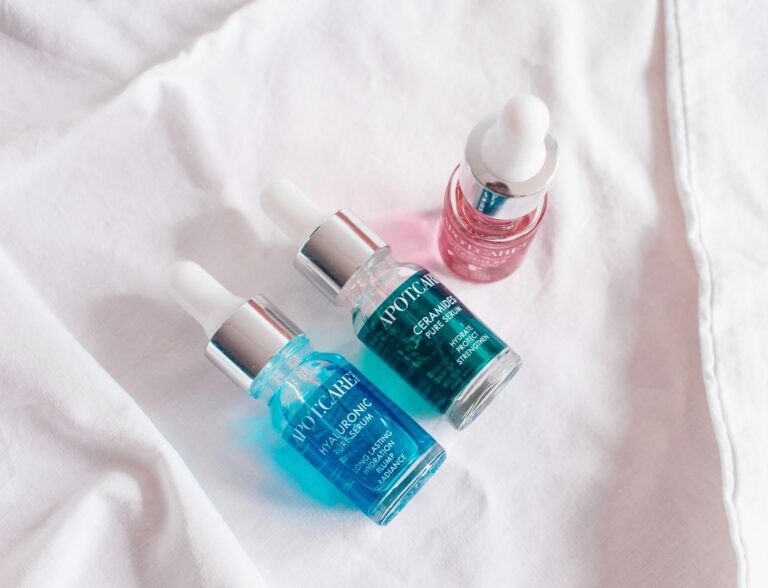
In the realm of cosmetic enhancement, fillers have become increasingly popular due to their remarkable ability to rejuvenate and enhance facial features. The range of fillers available, from hyaluronic acid to collagen-based options, caters to a variety of aesthetic goals. But do fillers hurt, and what about their reversibility?
This article will delve into the different types of fillers, the facial areas they can effectively treat, and what patients in the UK can expect during and after their treatment. Whether you are contemplating fillers for the first time or simply wish to refresh your understanding, this discussion will provide valuable insights to support you on your journey.
What Are the Different Types of Fillers?

When considering cosmetic procedures, it is important for patients in the UK to understand the various types of fillers for facial rejuvenation. Fillers are versatile substances that are injected into different areas of the face to enhance beauty, restore volume, and minimise the signs of ageing. While the price of dermal fillers in the UK can vary, understanding the options available helps patients make informed decisions that align with their goals and budget.
Each type of filler possesses unique properties and specific intended uses, so it is essential for patients to be well-informed about their choices. By understanding the differences between fillers, such as hyaluronic acid and collagen-based options, patients can better manage their expectations during treatment and ultimately achieve satisfaction with the results.
1. Hyaluronic Acid Fillers
Hyaluronic acid fillers rank among the most sought-after options in the beauty industry, recognised for their ability to deliver immediate results while enhancing facial aesthetics.
These fillers contain a naturally occurring substance known for attracting moisture, which aids in restoring volume and smoothing out wrinkles. The treatment process is quite straightforward, typically involving injections at specific sites on the face, allowing for a tailored approach that meets each patient’s unique needs.
One of the notable advantages of these fillers is their effectiveness in achieving natural-looking results that can refresh one’s appearance without the necessity of invasive surgery. Patients frequently report a quick recovery, with minor side effects such as swelling or bruising being manageable and short-lived. Safety is a crucial consideration; hyaluronic acid is biocompatible, meaning it integrates well with the body’s tissues.
Many individuals provide positive testimonials, emphasising not only the enhancements in their appearance but also the accompanying boost in confidence. Longevity is another appealing aspect, as the results from hyaluronic acid fillers can last several months, making them an attractive choice for those seeking enduring beauty enhancements.
2. Collagen Fillers
Collagen fillers are specifically designed to enhance the skin’s natural collagen levels, effectively improving facial volume and elasticity. These fillers offer a smoother and firmer appearance, making them suitable for various skin types. They can be particularly advantageous for older individuals or those experiencing significant skin laxity, as they work to restore a youthful look by replenishing lost collagen.
The application of collagen fillers typically involves a straightforward process that begins with a comprehensive consultation to discuss aesthetic goals and expectations. During the treatment, a trained professional administers the filler using a fine needle, carefully targeting specific areas such as the cheeks, lips, or nasolabial folds.
Patients can expect immediate results, which often improve over the following days as any swelling subsides.
It is essential for individuals considering this treatment to be informed about potential complications, including bruising, redness, or allergic reactions.
Proper patient education plays a critical role in managing expectations and ensuring that candidates, particularly those in older demographics, fully grasp the emotional and physical implications of the procedure. This understanding helps guide them in making informed decisions about their cosmetic enhancement journey.
3. Calcium Hydroxylapatite Fillers
Calcium hydroxylapatite fillers present a strong option for individuals seeking significant aesthetic enhancements with long-lasting results. These fillers not only provide volume but also promote collagen production in the skin, leading to an overall improvement in facial contours. Patients can anticipate a fuller appearance that may last for a year or more, which contributes to their popularity for various treatment objectives.
The distinctive properties of these fillers enable a natural-looking enhancement that integrates seamlessly with the body’s tissues, resulting in a smoother finish. Beyond their volumising effects, they also offer the added advantage of enhancing skin elasticity and smoothness.
It is important for individuals to be mindful of potential side effects, such as bruising or swelling at the injection site; however, these typically resolve within a few days. Ensuring patient comfort is of utmost importance, which underscores the need to select qualified and experienced practitioners.
Consulting with skilled professionals can help establish realistic expectations regarding the duration of treatment and recovery timelines, ultimately leading to a safer and more satisfying experience.
4. Poly-L-lactic Acid Fillers
Poly-L-lactic acid fillers present a distinctive option in the world of dermal fillers, primarily recognised for their ability to stimulate the body’s natural collagen production over time. These fillers are particularly effective for individuals seeking a gradual enhancement in facial volume and structure.
The results unfold over a few months, making it crucial for patients to manage their expectations and comprehend the healing process involved.
To fully benefit from these fillers, ongoing maintenance treatments are essential, as they assist in preserving the natural-looking enhancements achieved. Patients should also prioritise educating themselves about their aftercare to ensure optimal recovery, which includes avoiding strenuous activities and sun exposure immediately following treatment.
Individuals can anticipate long-lasting effects on their facial aesthetics, often experiencing improved skin texture and resilience.
With appropriate follow-up care, the longevity of the results can be extended, promoting a more youthful appearance over time. Engaging with healthcare providers about these aspects can give the power to patients to make informed decisions regarding their aesthetic journeys.
5. Polymethyl Methacrylate Fillers
Polymethyl methacrylate fillers offer a more permanent solution for individuals seeking long-term facial enhancements. These fillers consist of tiny microspheres that provide structure and support to the skin, making them a popular choice for those looking for significant and lasting results.
It is important for patients to be aware of the potential complications and to discuss all treatment options with their practitioner before proceeding.
Understanding the implications of choosing polymethyl methacrylate fillers is essential, as it involves not only the aesthetic benefits but also the associated risk factors that may arise from their use. Informed consent is crucial, which requires a thorough discussion about the quality of the product and the qualifications of the practitioner.
Additionally, it is vital to follow established safety protocols during the injection procedure to minimise the risk of adverse effects. By fostering an open dialogue, patients can make well-informed decisions that enhance their satisfaction with the results while also protecting their health.
What Areas Can Be Treated with Fillers?

Fillers can be used to treat various areas of the face, providing a customisable approach to aesthetic enhancement. Patients in the UK frequently seek these treatments to refine their features and achieve their beauty goals.
Common treatment areas include:
- the lips
- cheeks
- jawline
- under-eyes
- nasolabial folds
Each of these areas requires careful consideration of the injectables used and the desired results. It is essential for patients to understand the potential effects and recovery processes associated with each treatment area to ensure a satisfying experience.
1. Lips
Lip fillers have become increasingly popular in recent years, emerging as a preferred choice for individuals seeking to enhance the fullness and shape of their lips. With a variety of filler options available, patients can achieve the luscious, plump lips that align with their aesthetic desires. The treatment consists of targeted injections that can effectively reduce the appearance of fine lines and contribute to a more youthful appearance.
Among the most commonly used lip fillers are those based on hyaluronic acid, celebrated for their ability to deliver natural-looking results and ease of adjustment. The expected outcomes generally include enhanced lip volume and improved contours, which together help create a more balanced facial appearance.
It is essential to discuss the potential discomfort and swelling associated with the procedure; while these are usually mild and temporary, they can still impact the overall patient experience. Furthermore, aftercare is a vital aspect of the process. Following recommendations—such as avoiding strenuous activities and keeping the lips well-moisturised—will help ensure optimal healing and enhance satisfaction with the final results.
2. Cheeks
Cheek fillers present a remarkable option for individuals looking to restore facial volume and attain a more youthful, rejuvenated appearance. By adding volume to the mid-face, cheek fillers can enhance both contour and symmetry, effectively addressing concerns related to sagging skin or volume loss that often comes with ageing. This treatment typically involves minimal downtime and provides immediate effects, which can significantly boost a patient’s confidence.
There are various types of fillers available, such as hyaluronic acid, calcium hydroxylapatite, and poly-L-lactic acid. Each type offers different results and longevity, making it crucial for individuals to select a filler based on their specific needs and desired outcomes.
While most patients enjoy positive results, it is essential to be aware of potential side effects, such as swelling, bruising, or allergic reactions. This underscores the importance of choosing an experienced practitioner. The injector’s expertise not only ensures safety during the procedure but also enhances overall patient comfort.
This can significantly impact the psychological effects that aesthetic improvements can have on self-image and emotional well-being.
3. Jawline
Jawline fillers are gaining popularity among individuals seeking a more defined and sculpted jawline. This treatment can enhance the structural appearance of the lower face, creating balance and harmony within facial aesthetics.
With the appropriate filler and technique, patients can achieve a stronger jawline that not only enhances their profile but also boosts overall confidence.
Many individuals are opting for hyaluronic acid fillers, known for their versatility and safety, which provide natural-looking results. When pursuing jawline enhancement, it is crucial for patients to clearly communicate their treatment goals with practitioners to ensure that their expectations are met.
Plus hyaluronic acid, other options such as calcium hydroxylapatite may also be considered, depending on the desired longevity of the results.
Patients can anticipate an improvement in facial contouring with minimal downtime, leading to significant satisfaction when the outcomes align with their aesthetic aspirations. Engaging in comprehensive discussions about the procedure fosters a trusting relationship between the practitioner and the patient, ultimately enhancing the overall experience.
4. Under Eyes
Under-eye fillers serve as an effective solution for those seeking to diminish the appearance of dark circles and hollowness in the sensitive under-eye area. These fillers can help create a smoother and more youthful look, significantly enhancing facial aesthetics. When administered by a qualified practitioner, the treatment can produce impressive results with minimal discomfort.
It is essential to consider the qualifications of the practitioner, as their expertise greatly influences both safety and effectiveness. Patients should also be informed about the safety protocols in place at the facility, as these measures help reduce the risk of potential side effects such as swelling, bruising, or allergic reactions.
Additionally, managing expectations regarding the results and the recovery process is crucial. This allows individuals to have a clear understanding of the timeline for achieving optimal outcomes and the necessary aftercare practices. Such an approach not only increases overall satisfaction but also helps to build a trusting relationship between patients and practitioners.
5. Nasolabial Folds
Treating nasolabial folds with fillers can significantly enhance an individual’s facial appearance by smoothing out the deep lines that develop from the nose to the corners of the mouth. This area often becomes a focal point for those seeking to rejuvenate their looks, making it essential to select the appropriate filler and technique to achieve optimal aesthetic results. Many patients report high satisfaction rates after this treatment, noting a more youthful and refreshed appearance.
To achieve the best outcomes, practitioners commonly use dermal fillers such as hyaluronic acid, given their ability to integrate smoothly into the skin. The injection technique may vary, with many professionals opting for a micro-cannula approach to minimise discomfort and reduce the risk of swelling.
Most patients can expect mild swelling, which typically subsides within a few days, allowing them to quickly enjoy their enhanced appearance.
Follow-up care is crucial for maintaining results, as practitioners often recommend touch-up sessions to sustain volume and ensure that the treatment aligns with the patient’s evolving aesthetic goals.
What Can UK Patients Expect During and After a Filler Treatment?

Understanding what to expect during and after a filler treatment is essential for patients in the UK, as it contributes to a positive experience and outcome.
From the initial consultation to post-treatment care, being well-informed about the entire process can help manage expectations and ease any concerns regarding pain or discomfort.
During the consultation, patients should anticipate a comprehensive discussion about their medical history and treatment goals, which lays the groundwork for a successful procedure.
1. Consultation
The consultation represents a vital step in the filler treatment process, allowing patients to articulate their aesthetic goals and expectations with a qualified practitioner. During this session, practitioners have the opportunity to assess the patient’s medical history, skin type, and facial anatomy, which helps in creating a personalised treatment plan.
Clear communication at this stage is essential, as it ensures that patients feel informed and confident in their decisions.
This meeting also serves as an opportunity for practitioners to educate patients about the potential risks associated with the procedure, ensuring they understand both the benefits and limitations of fillers. Such an approach not only emphasises the importance of informed consent but also highlights the practitioner’s qualifications and expertise.
By addressing any concerns or questions the patient may have, practitioners can foster a trusting relationship, which ultimately makes patients feel more comfortable moving forward with the treatment. A well-executed consultation enhances patient satisfaction and aims for optimal aesthetic outcomes.
2. Preparation
Preparation for filler treatment is crucial for ensuring both safety and effectiveness, ultimately leading to a smooth procedure and optimal results. During this phase, there may be specific pre-treatment instructions, such as avoiding blood-thinning medications and alcohol, to reduce the risk of bruising and swelling.
Practitioners often discuss the application of numbing cream to enhance patient comfort during the injection process.
It is advisable for individuals to remain well-hydrated in the days leading up to the appointment, as proper hydration can promote better skin health and aid in the healing process. Additionally, patients should consider adjusting their skincare routines by steering clear of harsh exfoliants or treatments that could irritate the skin.
By adhering to these guidelines, patients not only minimise peri-procedural discomfort but also contribute to a more effective pain management strategy. This approach ensures that the filler treatment aligns with their cosmetic goals while reducing any potential discomfort.
3. Injection Process
The injection process is a crucial aspect of filler treatment, where the selected filler is meticulously administered to specific injection sites to achieve the desired aesthetic outcomes. While some patients may experience localised pain or discomfort during the injections, techniques such as applying a numbing cream can help alleviate these sensations. The practitioner’s skill and experience are vital in ensuring that the procedure is both comfortable and efficient.
To further improve the patient’s experience, advanced injection techniques, including the use of micro-cannulas, allow for greater precision while minimising trauma to the skin. These methods not only reduce discomfort but also lower the chances of bruising, promoting a smoother healing process.
Effective communication between the practitioner and the patient is essential throughout the procedure. Addressing any concerns can help build trust and foster a sense of ease. As the injections are carried out, the practitioner should consistently check in with the patient, making adjustments as needed to meet their expectations.
4. Results
Patients can generally expect to notice immediate effects following filler treatment, with results that enhance their facial aesthetics and boost their confidence. While some swelling or redness may occur initially, these symptoms typically subside within a few days, allowing the final outcome to emerge.
It is essential to understand the distinction between these immediate improvements and the long-term results to effectively manage patient expectations.
The type of filler used can greatly affect both the recovery timeline and the overall satisfaction of the patient. For example, hyaluronic acid fillers often yield results that last between six and twelve months and provide a more natural feel. Conversely, other options may offer a more enduring effect but may also come with longer recovery times.
Individual factors such as skin type, age, and lifestyle also play a significant role in the healing process and how one perceives the results. Most patients report an increase in emotional well-being and satisfaction as they witness their desired enhancements, highlighting the positive psychological effects that aesthetic improvements can bring.
5. Recovery Time
Recovery time following filler treatment is typically minimal, allowing most patients to resume their daily activities shortly after the procedure. While some individuals may experience slight bruising or swelling at the injection sites, the duration of these effects can vary based on personal healing factors and the type of filler used.
Being aware of the typical recovery timeline can help manage expectations and alleviate any anxiety regarding the process.
It is essential for individuals to prioritise aftercare during this period to ensure optimal healing. Many patients report experiencing some discomfort or increased skin sensitivity in the days following treatment, making it important to follow the post-treatment instructions provided by the practitioner.
This may involve gently applying ice packs to reduce swelling, avoiding strenuous activities, and steering clear of direct sunlight.
Additionally, scheduling a follow-up appointment with the healthcare provider for a routine check-in can further enhance the recovery experience. This allows for personalised adjustments should any concerns arise. Paying attention to these details can significantly impact overall satisfaction and the results of the treatment.
6. Possible Side Effects
Like any cosmetic procedure, filler treatments come with potential side effects that patients should be aware of before proceeding. Common side effects include redness, swelling, and localised pain, while serious complications, such as allergic reactions, are quite rare.
It is beneficial for patients to discuss these possibilities with a qualified practitioner during their consultation, as this can help them feel more prepared and informed.
Understanding the risk factors associated with filler treatments can enhance individual comfort levels. Reactions may vary based on factors such as skin sensitivity and the specific type of filler used.
Practitioners play a crucial role in adhering to safety protocols, which helps minimise the chances of adverse effects through proper technique and thorough patient evaluation. The experience and skill set of the practitioner significantly impact both the aesthetic outcomes and the likelihood of side effects. This highlights the importance of selecting a professional with a strong track record in cosmetic procedures.
Additionally, prioritizing patient comfort and effective pain management can contribute to a more satisfying overall experience.
7. Maintenance and Follow-up Treatments
To maintain the results of filler treatments, it is advisable for patients to schedule follow-up treatments at the recommended intervals. While the duration of results can vary based on the type of filler used and individual factors, regular maintenance helps ensure ongoing satisfaction with the aesthetic improvements achieved. Understanding the importance of post-treatment care and timely follow-ups is essential for long-term success.
Incorporating maintenance and follow-up treatments not only prolongs the effects of the results but also enhances the overall experience during the recovery period. These additional sessions provide practitioners with the opportunity to assess the effectiveness of the initial treatment and make any necessary adjustments to optimise outcomes.
During these check-ins, patients can explore various treatment options, ensuring that their aesthetic goals remain in sync with their evolving preferences. Establishing regular touchpoints with practitioners encourages open communication, allowing for personal insights into the effectiveness of the treatments and addressing any concerns that may arise.
This proactive approach is vital for achieving a refreshed and radiant appearance over time.
Frequently Asked Questions
Do fillers hurt during the treatment?
Most patients report feeling minimal discomfort during the treatment, as the fillers are injected with a very fine needle. Some patients may experience a slight stinging sensation, but this is typically well-tolerated.
What can UK patients expect during the filler treatment?
During the treatment, the practitioner will use a numbing cream or ice to help minimise any discomfort. They will then inject the filler into the desired areas, using a precise technique to achieve natural-looking results.
Will there be any pain or discomfort after getting fillers?
After the treatment, patients may experience some mild discomfort, redness, or swelling at the injection sites. This is normal and should subside within a few days. Over-the-counter pain relievers can help alleviate any discomfort.
Are there any side effects associated with filler treatments?
The most common side effects of filler treatments include temporary redness, swelling, bruising, and tenderness at the injection sites. These usually last for a few days and can be managed with ice and over-the-counter pain relievers.
How long do filler treatments typically last?
The duration of fillers can vary depending on the type of filler used and the individual’s metabolism. On average, fillers can last anywhere from 6 months to 2 years. It is recommended to have touch-up treatments every 6-12 months to maintain the results.
Is there anything patients should do after getting fillers?
After getting fillers, patients should avoid touching the treated area for a few hours and avoid strenuous exercise for 24-48 hours. It is also recommended to avoid excessive sun exposure and alcohol consumption for the first 24 hours after treatment.






